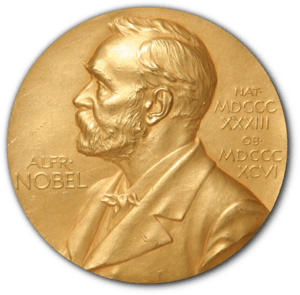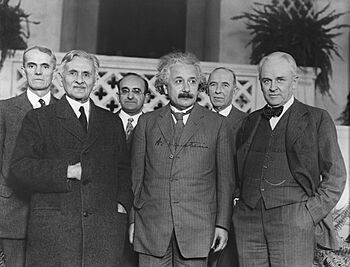Nobel Prize in Physics facts for kids
Quick facts for kids Nobel Prize in Physics |
||||
|---|---|---|---|---|
 |
||||
| Presented by | Royal Swedish Academy of Sciences | |||
| Location | Stockholm, Sweden | |||
| Reward | 11 million Swedish kronor (2023) | |||
| First awarded | 1901 | |||
| Currently held by | Anya Sharma, Ben Carter, and Chloe Davis | |||
|
||||
The Nobel Prize in Physics is a super important award. It's given every year to scientists who make the most amazing discoveries in the world of physics. Imagine finding out how the universe works or inventing something that changes our lives!
This prize is one of five Nobel Prizes. They were all started by a man named Alfred Nobel way back in 1895. The other prizes are for Chemistry, Literature, Peace, and Physiology or Medicine.
When someone wins, they get a special gold medal, a fancy paper called a diploma, and a good amount of money. The medal has a picture of Alfred Nobel on it.
The very first Nobel Prize in Physics went to a German scientist, Wilhelm Röntgen. He discovered X-rays, which let us see inside things, like bones! Many people think this is the most important award a physicist can get. The prizes are given out in Stockholm, Sweden, on December 10th each year. This date is special because it's the anniversary of Alfred Nobel's death. As of 2025, over 229 brilliant people have won this incredible prize.
Contents
The Story Behind the Prize
Alfred Nobel was a very wealthy inventor. He wrote a special will before he died. In his will, he said that most of his money should be used to create prizes. These prizes would honor people who brought the "greatest benefit to mankind." This included discoveries in physics, chemistry, peace, physiology or medicine, and literature.
Nobel signed his last will in Paris in 1895. He left a huge amount of money, about 31 million Swedish kronor, for these five prizes. It took some time for his will to be officially approved. Finally, in 1897, the Norwegian Parliament gave its approval.
After that, the Nobel Foundation was created. Its job was to manage Nobel's money and organize the prizes. Different groups were chosen to pick the winners for each prize. The Royal Swedish Academy of Sciences was given the important task of choosing the Nobel Prize winner in Physics.
How Winners Are Chosen

Winning a Nobel Prize in Physics is a big deal. Up to three people can share the prize. They can also be recognized for up to two different discoveries. The process for choosing winners is very long and careful. This is why it's considered such an important award in physics.
A special group called the Nobel Committee for Physics handles the selection. This committee has five members. They are chosen by the The Royal Swedish Academy of Sciences. The process starts in September. About 3,000 professors and past Nobel winners receive secret forms. They use these forms to nominate scientists they think deserve the prize.
These nomination forms must be sent back by January 31st of the next year. Then, experts carefully study and discuss all the nominees. They narrow the list down to about fifteen names. The committee then recommends the final candidates to the Academy. The Academy discusses these candidates further. Finally, they vote to choose the new Nobel Laureates in Physics.

The names of the people nominated are kept secret for 50 years! This means you won't know who was considered until many decades later. Also, someone cannot be nominated after they have passed away. However, if a person dies after the committee has already decided they will win, they can still receive the award.
There's a special rule for the Physics Prize. The importance of a discovery must be "tested by time." This means that usually, about 20 years pass between a discovery and when it wins the prize. Sometimes it's even longer! For example, Subrahmanyan Chandrasekhar won half of the 1983 prize for work he did in the 1930s. This rule ensures that only truly impactful discoveries are honored. However, it also means some scientists might not live long enough to see their work recognized.
What Winners Receive
Winners of the Physics Nobel Prize get three main things: a gold medal, a special diploma, and a sum of money.
The Special Medals
The medal for the Nobel Prize in Physics looks just like the one for Chemistry. On the back, it shows the Goddess of Nature. She is shown coming out of clouds, holding a cornucopia (a horn of plenty). The Genius of Science is lifting a veil from Nature's face.
A Swedish artist named Erik Lindberg designed this medal. It has a Latin phrase inscribed on it. This phrase means, "It is beneficial to have improved human life through discovered arts." Below the figures, the winner's name is engraved.
Unique Diplomas
The King of Sweden personally gives each Nobel winner their diploma. Every diploma is a unique piece of art. It's designed especially for the person receiving it. The diploma includes a picture and a written explanation of the winner's amazing achievements.
The Prize Money
Along with the medal and diploma, winners receive a document stating the prize money. The amount of money can change each year. It depends on how much funding the Nobel Foundation has. For example, in 2009, the prize was 10 million Swedish Kronor. In 2012, it was 8 million Swedish Kronor.
If two people share the prize, the money is split equally between them. If there are three winners, the committee might divide it equally. Or, they might give half to one person and a quarter to each of the other two.
The Award Ceremony
The names of the winners are usually announced in early October. Then, a formal ceremony takes place every year in Stockholm Concert Hall. This happens on December 10th. At this special event, the laureates receive their diploma, medal, and the document confirming their prize money.
See also
 In Spanish: Anexo:Ganadores del Premio Nobel de Física para niños
In Spanish: Anexo:Ganadores del Premio Nobel de Física para niños
- List of Nobel laureates in Physics
- Fundamental Physics Prize
- List of physics awards
- Sakurai Prize, presented by the American Physical Society
- Wolf Prize in Physics



